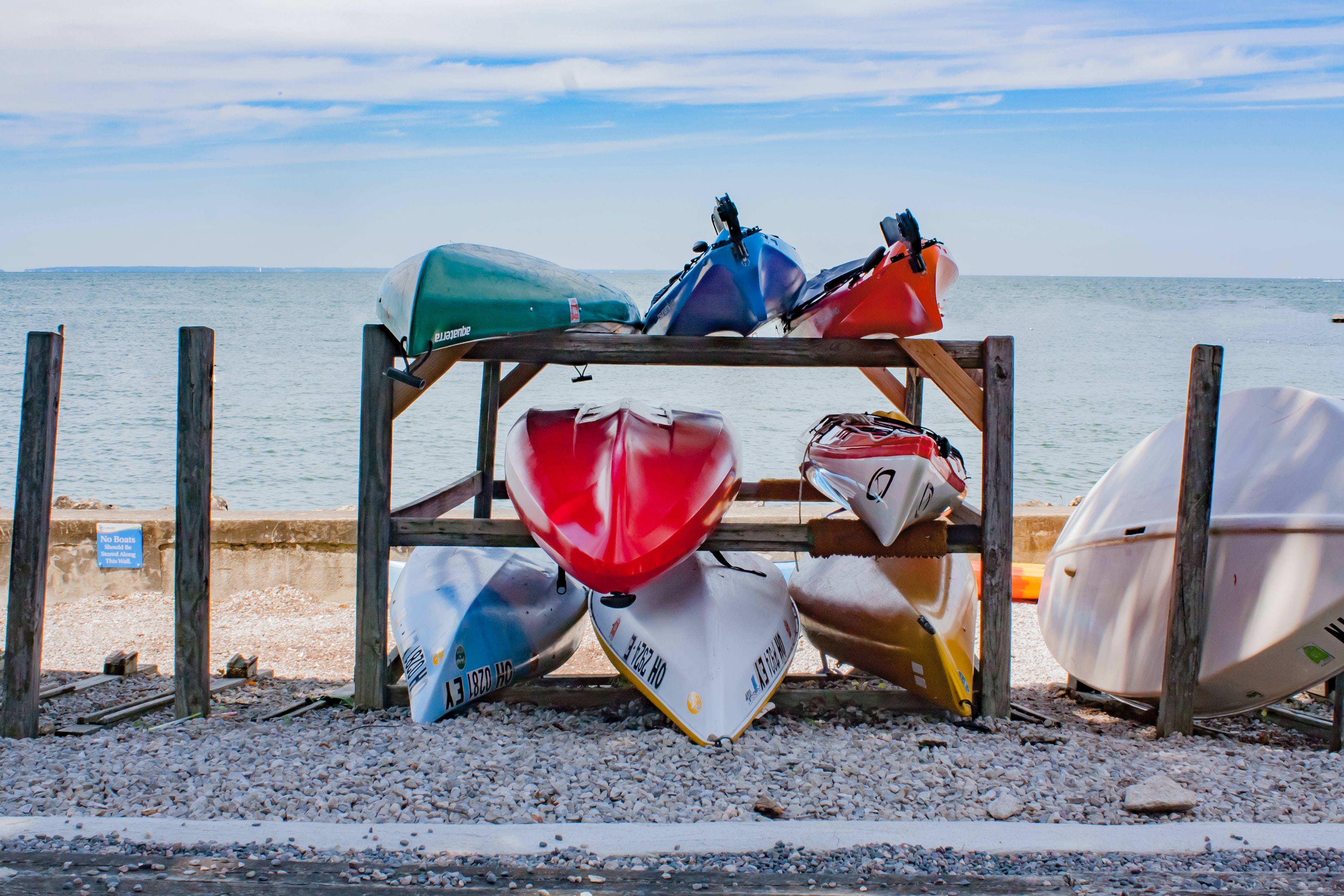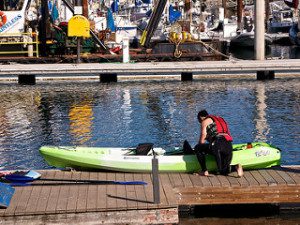
Over the past few decades kayak thefts cases have increased. Kayaks may not seem like something that would be stolen but think again. If you want to prevent kayak theft, the best solution is to keep it locked up when it’s not in use. Of course, keeping the kayak safe in a secured building like a locked shed or garage is best but if this isn’t an option or you’re taking the kayak out on the road, you’ll need additional strategies.
Unfortunately, kayaks are a popular item to steal because some cost a lot, they’re difficult to lock up and also difficult to find once stolen. A comprehensive plan to keep your kayak safe is the best strategy.
If you’ve had a kayak stolen or are concerned about keeping yours safe, this overview will cover the specifics of what every kayak owner should do to keep their kayak from being stolen.
Here’s a Short infographic on How to Prevent Kayak Theft. Feel free to download or share it if you like.
1. Keep the Kayak Locked at Home
Many kayak owners believe that their kayaks are safe when they’re on their own property. Unfortunately, it’s easy to sneak in and steal a kayak overnight or when the owners are out of town. Keeping the kayaks stored inside a locked garage or shed is the best solution. A freestanding kayak rack, a wall-mounted rack, or a suspension system in the garage are all viable options for secure indoor storage.
If there simply isn’t room inside the property for the kayak, then the next best solution is to secure the kayak as close to the house as possible. A tree or a permanent structure can be an option. Lock the kayak to the tree using the kayak handles or the scupper plug holes. It’s also a good idea to cover the kayak with a tarp to keep it out of sight.
2. Lock the Kayak While Traveling
Since many people use their kayaks at locations away from their home, keeping the kayak secured on the roof of the cars is ideal. Not only does the kayak need to be secured from thieves, it also needs to be tied down for secure transportation. There are kayak locks available but a bicycle cable lock is all that’s needed. For additional protection, consider using lockable straps.
Sit-inside may not have a drain hole or scupper hole, making locking them more difficult. Some kayaks may have cable bars which can be used for security. A lasso locking cable is also an option. It is even possible to drill and install a cable lock although be careful to not cause any problems with the watertight hull.
3. Lock the Kayak Away from Home
The third place where a kayak can be stolen is when away from home at a campsite or cabin. Since this is the time when a kayak is most likely to be stolen, security should be emphasized. When traveling with the kayak, a cable lock can be used to secure the kayak to a trailer or the car rack. This is typically adequate to prevent theft.
If leaving the vehicle behind, security may be more challenging. Kayaks that are inflatable or folding are surprisingly travel-friendly and can typically be stored inside the tent. Hard-shell kayaks will require being locked to a permanent structure such as a tree. Docks and even logs may be an option as well, provided that it’s too difficult to remove the lock.
For kayak accessories, keeping them safe is also challenging. Keep them in the tent or cabin if possible. The kayak may also have a storage area where items can be stored securely. Paddles can be more cumbersome but paddle-locks are a worthwhile investment that can be a good option.
4. Register Your Kayak & Record HIN
What some kayak owners may not know is that in some states, kayaks are registered. All kayaks that are made after 1972 have a hull identification number. This is a 12-digit code that is typically placed near the stern of the boat. It serves as the kayak’s ID, similar to the ID for a car. If the kayak is stolen, having the HIN is a valuable tool. It may be challenging to find the kayak but providing authorities with the HIN gives them a better likelihood of identifying it.
Thieves who are aware of the HIN may try to remove it, which is fairly easy. However, smart kayak owners will mark the HIN in an inconspicuous spot. Look for an area below the deck or under the seat and mark the HIN with a waterproof and long-lasting marker. Keep a record of the location of the HIN. For states where kayaks are registered, make sure that the correct number is registered and records are kept up to date.
5. Consider Kayak Insurance
Although the best way to prevent kayak theft is to secure the kayak and accessories, even proper precautions may not be enough. If there have been thefts in the area, buying kayak insurance is an option. Some homeowner insurance policies may already cover the cost of a kayak up to $1,000, so check the policy before buying.
If kayaks are not included or the kayak is worth more than what the policy states, record the kayak as a scheduled watercraft. This will cost kayak owners an additional premium but provide peace of mind if the kayak is stolen.
6. Consider using a Gps tracker or a similar device

If you have ever used a pet tracker GPS or even a key ring finder gps then same thing can also be used for kayak safety . These devices are to hide and can be accessed via phone directly. They track the location in case the theft happens or sometimes even raise an alarm.
When Storing the Kayak at home or in the cabin somewhere far, you can attach a gps tracker or anti theft device in an area where it is not easily visible. Certain areas that come to mind could inside the deck hatch , in cockpit, under the seat etc.
7. Add Your Unique Mark to the Kayak
People can prevent kayak theft by bolting it to the rooftop rack or inside the house. However, an ideal approach to keep somebody from taking your things is to make them less attractive. Don’t go ahead and drill holes in your kayak or splash graffiti on top of it. Instead, just add additional recognizable proof to it like indelible markers , little microdots etc.. and tell the public that your gear has been marked for distinguishable evidence.
9. Avoid buying a stolen Kayak
Avoiding buying stolen Kayaks can also act as a way of minimizing their theft, this can be achieved by always going to the sellerís home to purchase a kayak. Approach the dealer for the model, hues and a serial number of the kayak and you can even call the police to check the serial number.
10. Report a suspicious kayak seller to police
Yeah, reporting to the police about any kayak that you suspect to be taken can also help curb their theft. You should do this if the price offered is too good to be true, or there is no attached photo of the kayak in use during negotiations. Moreover, you could raise the alarm when the seller wants to meet you somewhere else or even offers to bring the kayak to your location. Notify the police of your suspicion, and let them handle the rest.
Conclusion
Kayaks are a considerable investment, and must be taken care of properly to prevent theft and damage. The primary part of preventing kayak theft is simply making sure that the kayak is locked at all times when not in use. Keep the kayak out of sight as much as possible and in a secure location.
By following these precautions, kayak owners have the best likelihood of ensuring that their kayak remains safe regardless of its location. Invest in a good quality lock for the kayak for the best results. With the proper precautions, it’s unlikely that a kayak will be stolen.
Even If, the kayak is taken, having the proper documentation and insurance may help with recovery efforts or replacement.



